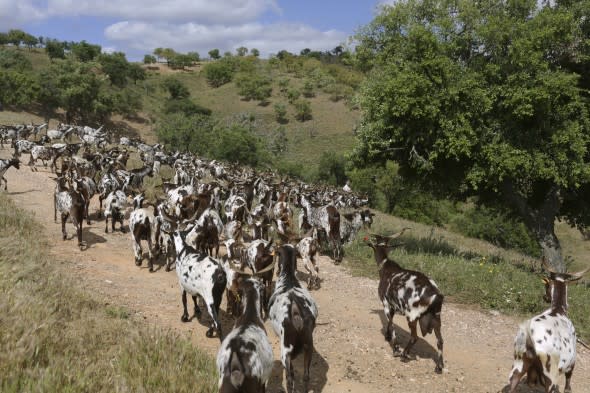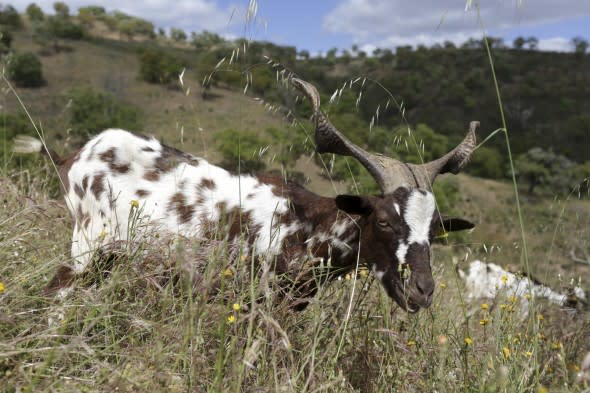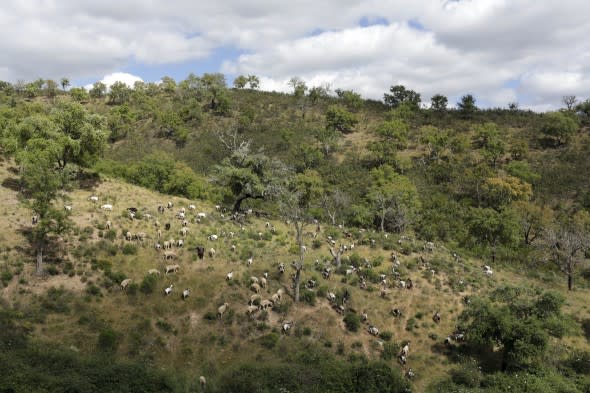Goats may be Portugal's secret weapon for fighting wildfire threats
Wildfires are fairly common across Portugal during their normally dry summer months. Wildfires were a large problem in Portugal last year, resulting in approximately 106 deaths.
To prevent another catastrophe, Portugal is using an ancient and reemerging strategy to fight the growing wildfire threat as dry summer months approach: goats.
The Portuguese government is sending in hundreds of goats with hope of reducing this threat. These goats will hopefully clean up as much woodland as possible before temperatures rise and the land becomes a tinderbox.

Daniel Fernandes leads his herd of goats down a slope in Moita da Guerra, on the hills of southern Portugal's Algarve region on June 5, 2018. The Portuguese government is hiring dozens of goat herds nationwide to guard the country against a repeat of last year's catastrophic wildfires. (AP Photo/Armando Franca)
"Rainfall during the winter and spring provides water for grasses and other plants to grow, but this vegetation dries out in the heat and dryness of summer," AccuWeather Senior Meteorologist Jason Nicholls said.
The dried vegetation provides the fuel for wildfires later in the summer.
Rainfall has been above normal across much of Spain and Portugal through the spring, likely resulting in a large amount of vegetation, AccuWeather Meteorologist Eric Leister said.
"The biggest thing this year is that rainfall has been abundant so far this year in Portugal compared to normal and compared to recent years," Leister said.
Overall, rainfall has been 100 to 200 percent of normal across the country since January.
"This significant increase in rainfall compared to normal has limited the threat for wildfires so far this spring and summer, and it will likely continue to limit the threat for fires through much of the summer," Leister said.
Comparing to last year when wildfires were a huge problem, rainfall was only 50-100 percent of normal.
If a turn to very dry weather occurs during the mid- and late summer, there could be an increase in wildfires late in the season, according to Leister.
"The pattern looks to stay favorable to keep the wildfire risk low across much of Portugal through at least the end of June," Nicholls said. "If most modeling is correct, the wildfire may stay fairly low in northern Portugal through July and maybe into August."
However, rainfall will not be as likely over the southern third of the nation, so there may be elevated risk of fires in that region come late July, August and September, Nicholls said.
While the ancient technique of sending in livestock, like goats and sheep, for managing fuel used to be quite common, it is currently being rediscovered in the United States and other nations, according to University of California Cooperative Extension (UCCE) Livestock and Natural Resources Advisor Dan Macon.
"From a scientific perspective, we're now rediscovering how to do it effectively and how to target that kind of effort to particular fuel types," Macon said.
It's an emerging science in the nation. Universities and other interest groups have started to study the technique more over the last 15 to 20 years. They have been looking at the success rate of this technique.
"From the University of California standpoint, we're really looking at a variety of measures of success in terms of the scientific validation of this technique," Macon said.

A goat grazes on a slope in Moita da Guerra, on the hills of southern Portugal's Algarve region on June 5, 2018. Portugal is using goats to try and clean up as much woodland as possible before temperatures rise and the land becomes a tinder box. (AP Photo/Armando Franca)
Recent evidence shows that has been very successful in slowing the spread of wildfire in areas that are dominated by fine fuels.
Their performance depends on where the fuel treatment is taking place. Density of fuel, accessibility to water, forage quality and cost of labor can vary even within the same forest, Macon said.
More research is needed to determine the economic success.
"It's certainly more effective in treating large landscapes, but understanding what the total cost of using that technique is something we're still working on," Macon said.
From a cost perspective, goats are much more expensive than mechanical or chemical treatment options but are cheaper than paid hand crews.
Goats and sheep can get to places that are very difficult to get people into. They tend to work well where it's too costly to mow or to use herbicides and other kinds of mechanical treatments.
In the U.S., there's a growing segment of the livestock industry that is charging for this service.
"It can be more cost effective, but it also allows you to treat areas that are difficult to reach otherwise," Macon said.

A goat climbs on a cork oak tree to reach the leaves, in Moita da Guerra, on the hills of southern Portugal's Algarve region on June 5, 2018. (AP Photo/Armando Franca)

A herd of more than 200 goats slowly munches its way through the thick undergrowth covering the hills in Moita da Guerra, in southern Portugal's Algarve region on June 5, 2018. (AP Photo/Armando Franca)
The technique can impact the livestock's reproductive success, especially if females are consuming those fuels in fairly difficult terrain. The impact on their nutrition may have adverse effects on reproduction.
The tactic may also cause problems with erosion or soil compaction, especially if a livestock manager is not paying attention to the balance between removing the fuel and leaving enough vegetation to protect those hillsides once it starts to rain again, according to Macon.
However, there is a variety of ways that the livestock can be managed effectively. The sheep or goats may be herded into an area using herd dogs or people. Portable electric fencing is used commonly to contain the animals in this nation.
The livestock manager will also need to manage all the impacts that those livestock have.
The livestock tramples a lot, which can have some beneficial effects in terms of fire protection.
"It lowers that fuel down to the soil level and reduces the amount of oxygen surrounding the fuel, which limits fire spread," Macon said.
The manager will also want to manage the nutrient cycle. Grazing animals are not adding nutrients; they're simply cycling nutrients in that system, Macon said.
The water quality of waterways can become one of the beneficial attributes of grazing and recycling those nutrients.
The overall success of this strategy is still being monitored by researchers.
